Fukushima First Batch of Nuclear Wastewater: IAEA Releases Independent Test Results
- EB Virus Could Be Infected by Kiss: A Hidden Threat Linked to Cancer
- The Silent Threat: How Gas Stoves Pollute Our Homes and Impact Health
- Paternal Microbiome Perturbations Impact Offspring Fitness
- New Report Casts Doubt on Maradona’s Cause of Death and Rocks Manslaughter Case
- Chinese academician unable to provide the exact source of liver transplants
- Early Biomarker for Multiple Sclerosis Development Identified Years in Advance
Fukushima First Batch of Nuclear Wastewater: IAEA Releases Independent Test Results
- AstraZeneca Admits for the First Time that its COVID Vaccine Has Blood Clot Side Effects
- Was COVID virus leaked from the Chinese WIV lab?
- HIV Cure Research: New Study Links Viral DNA Levels to Spontaneous Control
- FDA has mandated a top-level black box warning for all marketed CAR-T therapies
- Can people with high blood pressure eat peanuts?
- What is the difference between dopamine and dobutamine?
- How long can the patient live after heart stent surgery?
Fukushima Completes First Batch of Nuclear Wastewater Discharge: IAEA Releases Independent Test Results, South Korea Conducts On-Site Inspection.
On August 24th, Japan’s Fukushima Daiichi nuclear power plant began discharging treated nuclear wastewater. Over the past few days, several significant developments have emerged:
01. Completion of the First Phase of Discharge:
On September 11th, Tokyo Electric Power Company (TEPCO), the operator of the Fukushima Daiichi nuclear power plant, announced the completion of the first batch of nuclear wastewater discharge. In a span of 17 days, a total of 7,800 metric tons of wastewater were discharged.
The cumulative amount of nuclear wastewater at the Fukushima Daiichi nuclear power plant exceeded 1.3 million metric tons, originating from cooling water for damaged reactors following the 2011 tsunami-induced nuclear accident, as well as groundwater and rainwater contaminated due to the nuclear incident. In April 2021, Japan announced plans to release this wastewater into the sea, based on analysis and research dating back to 2013. The entire treatment process involves the following steps:

The nuclear wastewater undergoes treatment through the Advanced Liquid Processing System (ALPS), which can remove 62 radioactive elements except for tritium and carbon-14. Since the initial concentration of carbon-14 is relatively low, the goal of ALPS treatment is to reduce the concentration of all other radioactive elements to below discharge standards, apart from tritium. Tritiated water, similar to wastewater from regular nuclear power plants, is diluted with seawater by more than 100 times before being discharged into the sea, reducing tritium’s radioactivity to below 1,500 Bq/L, well below the WHO’s upper limit for tritium in drinking water (10,000 Bq/L).
Following the proposal of the discharge plan, Japan invited the International Atomic Energy Agency (IAEA) to review the discharge scheme. After detailed design and approval by regulatory authorities (requiring approval from Japan’s Nuclear Regulation Authority, NRA), TEPCO’s discharge plan obtained IAEA’s endorsement and NRA approval in July 2023, ultimately commencing on August 24th.
The Fukushima nuclear wastewater discharge follows a planned, phased approach. The daily discharge does not exceed 500 metric tons, and the annual tritium discharge is capped at 22 terabecquerels (Tbq). According to the discharge plan, TEPCO has specifically constructed a K4 nuclear wastewater storage area, which consists of four groups of water tanks named A, B, C, and E. A-C are designated for receiving, monitoring, and confirming the compliance of nuclear wastewater with discharge standards, with each group comprising 10 interconnected 1,000-cubic-meter water tanks, each group assigned one of the three functions at any given time. The E area has 5 water tanks solely for storage:
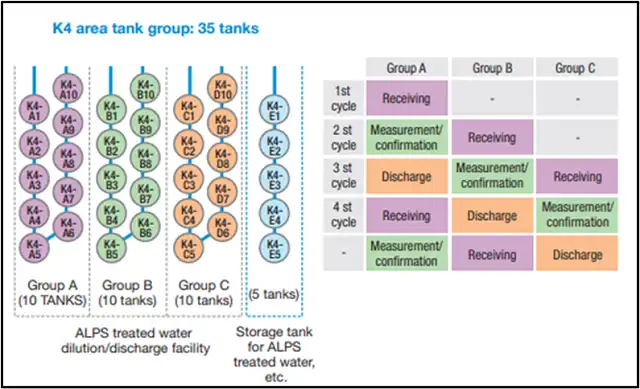
The first batch of discharged wastewater is exclusively from the K4-B tank area. Since this was the earliest planned release, the initial international independent laboratory testing organized by the IAEA also sampled from the K4-B area. The joint testing was completed in March 2022, and the comprehensive comparison report of data from various laboratories was published by the IAEA in May 2023, indicating that the primary radioactive element in this nuclear wastewater is tritium, with extremely low levels of other radioactive substances, consistent with expectations.
Furthermore, the report reveals that TEPCO’s test results align closely with the results from three IAEA-affiliated laboratories, as well as independent laboratories in Switzerland, the United States, France, and South Korea. This validation of testing methods during the nuclear wastewater discharge process has been achieved.
Radiation data from the K4-B area, as obtained through the joint testing by multiple international laboratories, can be referenced in the IAEA report, with select excerpts provided below:
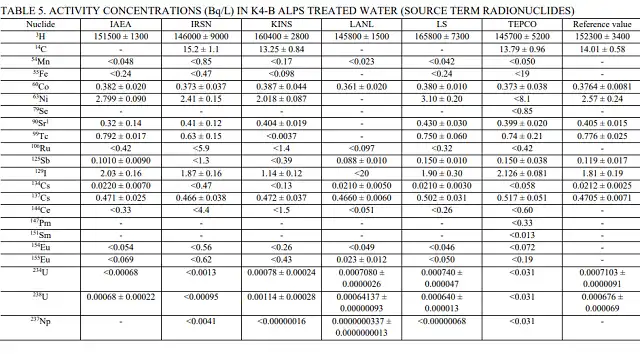
As expected, TEPCO completed the discharge from the K4-B tank area within 17 days, discharging approximately 7,800 metric tons of nuclear wastewater. In the coming weeks, TEPCO plans to inspect and clean the discharge equipment and pipelines. If all goes as planned, an additional 7,800 metric tons of nuclear wastewater from 10 more storage tanks in the K4 area will be discharged. According to TEPCO’s schedule, a total of 31,200 metric tons of nuclear wastewater will be discharged by March 2024, calculated in batches of 7,800 metric tons each, with an acceleration in the discharge rate expected thereafter.
02. IAEA Independent Environmental Sampling Confirms Compliance:
On September 8th, the IAEA also issued a press release announcing that samples collected by the IAEA near the discharge point of Fukushima’s nuclear wastewater had been tested and found to have tritium levels below the predetermined discharge standards.
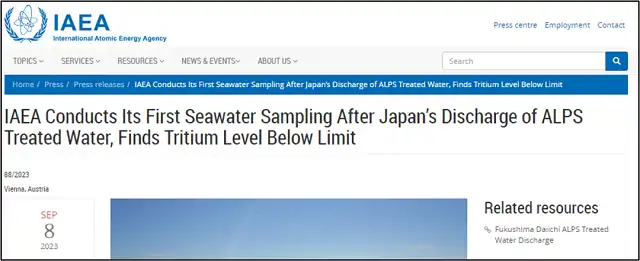
During the nuclear wastewater discharge process, TEPCO conducted real-time monitoring of tritium at the discharge point. Since ALPS-treated water only exceeds discharge standards for tritium, the dilution of seawater before discharge is aimed at reducing tritium concentration to prevent the release of radioactive wastewater above standards. Real-time monitoring of tritium is essential to confirm whether dilution is adequate and whether discharge complies with standards.
Throughout the discharge process, the IAEA provided TEPCO’s real-time monitoring data directly on its website, and, for instance, the IAEA website currently indicates that wastewater discharge has been temporarily halted:
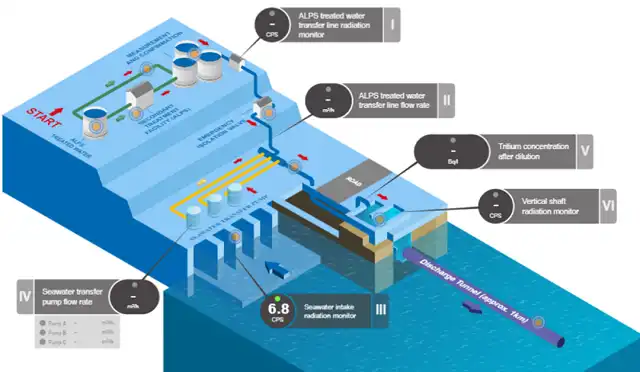
In previous discharge operations, tritium radioactivity levels in diluted wastewater were approximately 200 Bq/L, well below the set upper limit of 1,500 Bq/L.
These test results are from TEPCO; however, the IAEA maintains an on-site office at the Fukushima Daiichi nuclear power plant. IAEA staff not only supervised TEPCO’s sampling work during international laboratory joint testing but also conducted independent environmental sampling in various locations within a three-kilometer radius of the Fukushima Daiichi nuclear power plant, including both offshore and onshore areas. The press release also includes some photos taken by IAEA staff during their sampling.
The press release describes the test results of these environmental samples, stating that the tritium levels in seawater, as independently sampled and tested by the IAEA near the coastline, match the data from TEPCO and Japan’s Ministry of the Environment.
The IAEA mentioned that it will continue such seawater testing in the future.
03. South Korean Expert Team Visits Fukushima:
In addition to TEPCO’s announcement of the completion of the first batch of nuclear wastewater discharge on September 11th, another statement from the IAEA mentioned that an expert team from the Korea Institute of Nuclear Safety (KINS) had been visiting the IAEA office in Fukushima. The South Korean expert team arrived in Fukushima two weeks ago and met with IAEA officials.
South Korea’s involvement in Fukushima can be traced back to an IAEA press release on August 22, 2023, just two days before the start of the nuclear wastewater discharge:
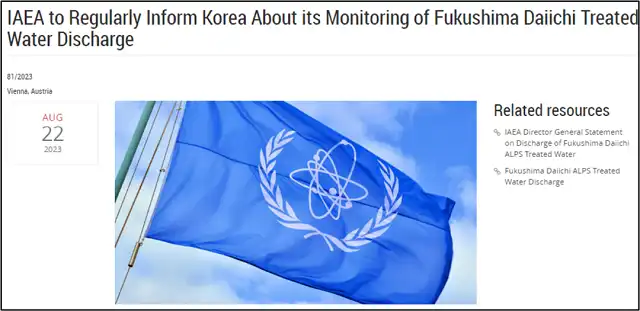
According to the press release, the IAEA committed to promptly providing South Korea with information on the nuclear wastewater discharge to ensure transparency for the public.
In the interest of transparency, the two parties formally established the IAEA-Korea Fukushima Information Sharing Mechanism (IKFIM) in the days leading up to the expected nuclear wastewater discharge. Under this mechanism, the IAEA, which has set up a permanent office in Fukushima, will provide South Korea
with the latest data and information regarding nuclear wastewater discharge regulation. Additionally, it will facilitate visits by South Korean experts to the Fukushima office.
IKFIM also includes protocols for handling unforeseen situations. According to an IAEA press release, the planning for IKFIM began shortly after the IAEA published its comprehensive report on Fukushima nuclear wastewater discharge. Following the submission of the comprehensive report to the Japanese government by IAEA Director-General Grossi in July, he immediately traveled to South Korea to explain the report to the South Korean government and opposition party leaders.
The on-site inspection of the South Korean nuclear safety expert team in Fukushima appears to be a practical step within the framework of IKFIM. Director-General Grossi commented when IKFIM was established: “From the moment we began assessing the safety of the discharge, I have been in touch with South Korea and other countries to make them aware of our important activities in this regard. The only way to address reasonable public concerns is to keep them informed. Today’s agreement underscores the importance of transparency in the coming weeks, months, and years.”
Clearly, we can anticipate the continued release of independent, transparent, and scientifically sound data by organizations like the IAEA in the future.
Reference:
https://apnews.com/article/japan-fukushima-nuclear-wastewater-release-f57e1c5f3b034996fdaa3371e33c7e17
https://www.meti.go.jp/english/earthquake/nuclear/decommissioning/pdf/202104_bp_breifing.pdf
https://www.iaea.org/sites/default/files/first_interlaboratory_comparison_on_the_determination_of_radionuclides_in_alps_treated_water.pdf
https://www.iaea.org/sites/default/files/iaea_comprehensive_alps_report.pdf
https://www.iaea.org/newscenter/pressreleases/iaea-conducts-its-first-seawater-sampling-after-japans-discharge-of-alps-treated-water-finds-tritium-level-below-limit
Fukushima First Batch of Nuclear Wastewater: IAEA Releases Independent Test Results
(source:internet, reference only)
Disclaimer of medicaltrend.org
Important Note: The information provided is for informational purposes only and should not be considered as medical advice.



